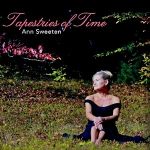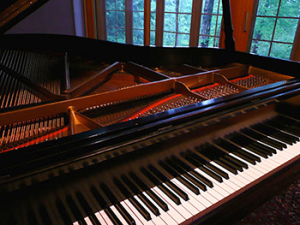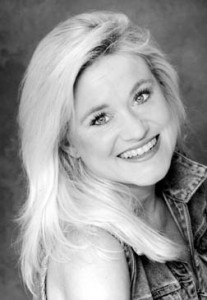 As guitarist/songwriter Steve Miller sang in one of his many radio classics: “Time keeps on ticking… into the future.” The subject of time is one that has intrigued artists, musicians, and writers, inspiring them to create reflections of its mysteries. The new album, Tapestries of Time, by award-winning pianist and official “Steinway Artist” Ann Sweeten, is one of these. In her words: “The pieces on this album have to do with time in some concept or other. There may be a direct reference, a captured moment, an isolated experience or inspiration drawn from a particular event, the idea of infinity and limitless possibility.” Tapestries of Time marks the 10th release from this multi-talented artist. Having written about her previous album, In The Wake, which included details about her background and many artistic facets, I’ll refer readers who may be interested to that feature article for more information. However, by way of providing just the briefest of overviews, I’ll reiterate my saying that: “although currently known as a “composer/ concert pianist/ arranger/ producer,” Ann Sweeten’s past palette of artistic endeavors paints a larger, and even more multi-talented picture. As well as her achievements as a pianist, she has had a career as a professional actress, a singer in musical theater, a trained ballet dancer, and even fronted a rock band. Her formal education includes a degree in foreign languages from Smith College, as well as later studies in Paris and at the Boston Conservatory. In addition to the arts, she is an avid animal activist and environmentalist.” And according to her bio, Ann is one of the most decorated pianists of the past decade, with 6 previous albums all ranking in the Top 5 NAR and ZMR Radio Reports, as well as being one of the most played modern instrumentalists in North America. A true renaissance woman, Ann Sweeten only continues to expand her horizons as time marches on.
As guitarist/songwriter Steve Miller sang in one of his many radio classics: “Time keeps on ticking… into the future.” The subject of time is one that has intrigued artists, musicians, and writers, inspiring them to create reflections of its mysteries. The new album, Tapestries of Time, by award-winning pianist and official “Steinway Artist” Ann Sweeten, is one of these. In her words: “The pieces on this album have to do with time in some concept or other. There may be a direct reference, a captured moment, an isolated experience or inspiration drawn from a particular event, the idea of infinity and limitless possibility.” Tapestries of Time marks the 10th release from this multi-talented artist. Having written about her previous album, In The Wake, which included details about her background and many artistic facets, I’ll refer readers who may be interested to that feature article for more information. However, by way of providing just the briefest of overviews, I’ll reiterate my saying that: “although currently known as a “composer/ concert pianist/ arranger/ producer,” Ann Sweeten’s past palette of artistic endeavors paints a larger, and even more multi-talented picture. As well as her achievements as a pianist, she has had a career as a professional actress, a singer in musical theater, a trained ballet dancer, and even fronted a rock band. Her formal education includes a degree in foreign languages from Smith College, as well as later studies in Paris and at the Boston Conservatory. In addition to the arts, she is an avid animal activist and environmentalist.” And according to her bio, Ann is one of the most decorated pianists of the past decade, with 6 previous albums all ranking in the Top 5 NAR and ZMR Radio Reports, as well as being one of the most played modern instrumentalists in North America. A true renaissance woman, Ann Sweeten only continues to expand her horizons as time marches on.
Like her last album, this one was also recorded at the studio of Grammy winning producer and Windham Hill  Records founder Will Ackerman, who co-produced the album along with Ann. And as can often be expected on a project recorded at Will’s Imaginary Roads Studio, a number of fine musicians are on hand to add accompaniment to some of the tracks, which also features engineering and mastering by studio wiz Tom Eaton. The album opens with a musical portrayal of that state which sometimes lingers after a pleasurable experience, on a track called “Afterglow.” The piece begins as a piano solo, played of course, on the world-class customized Steinway grand that Imaginary Roads Studio is famous for. The haunting melody is soon accompanied by the warm woody cello tones of Eugene Friesen, who is well known as a member of the Paul Winter Consort. The duo soon becomes a trio as they are joined on English horn by Akane Setiawan, a veteran wind instrument player and native of Kyoto, Japan who now resides in Canada. “Afterglow” makes a lovely point of departure for this temporal journey.
Records founder Will Ackerman, who co-produced the album along with Ann. And as can often be expected on a project recorded at Will’s Imaginary Roads Studio, a number of fine musicians are on hand to add accompaniment to some of the tracks, which also features engineering and mastering by studio wiz Tom Eaton. The album opens with a musical portrayal of that state which sometimes lingers after a pleasurable experience, on a track called “Afterglow.” The piece begins as a piano solo, played of course, on the world-class customized Steinway grand that Imaginary Roads Studio is famous for. The haunting melody is soon accompanied by the warm woody cello tones of Eugene Friesen, who is well known as a member of the Paul Winter Consort. The duo soon becomes a trio as they are joined on English horn by Akane Setiawan, a veteran wind instrument player and native of Kyoto, Japan who now resides in Canada. “Afterglow” makes a lovely point of departure for this temporal journey.
One of the more unique song titles is “Cavu,” which is an aviation term standing for “Ceiling And Visibility Unlimited,” and is a tribute to Ann’s father who was a former WWll Navy pilot. The inclusion of Andrew Eng’s violin adds to the soaring ‘above the clouds’ feel of the song. One of my favorite tracks was the dreamy “Ventanas Al Mar.” The inspiration for this came while Ann was vacationing in Cozumel, Mexico, and in her words: “we came upon a small hotel, very rustic, no electricity to speak of, but looking out on wild seas and jagged cliffs. Then I noticed the little sign for it, which said, “Ventanas Al Mar” – Windows to the Sea – and I thought it a perfect title echoing the idea of time in the endless, limitless view, it so graciously offered.” On the album’s title track, the interplay of piano and English horn is exquisite, and the various movements the piece flows through provide a showcase for Ann’s impressive skills as pianist, composer, and arranger. A track entitled “The Great Divide” is based on a poem Ann wrote about the line between childhood and adulthood, and the necessity “to keep alive the magical light of one’s inner child!” It’s a graceful and romantic composition with a wisp of nostalgia, which is further accented by the violin of Andrew Eng. On a solo piano piece called “The Hourglass,” delicate arpeggios evoke an image of the tumbling sands of time that measure the moments of our lives. The album draws to an absolutely gorgeous conclusion with another of my favorite tracks, this one featuring piano and oboe. Ann speaks eloquently and personally about the inspiration for it: “Riversong is about a place dear to my heart that remains timeless – there long before me and certain to remain long after. Conversely, my memories there, fleeting moments of sunlight framed by the banks of this most majestic waterway, are almost mocked, by the river’s never-ending flow.”
 I have to agree with Will Ackerman when he said of Ann and her new album: “the pieces on her new recording continue to surprise with their stunning performance and episodic composition, but are somehow more cohesive and focused than ever. Not content to rest on her laurels, Ann Sweeten continues to evolve as an artist and performer.” Having reviewed Ann’s previous album, In The Wake, which I liked very much, her musical evolution is evident in the deeply personal and heartfelt compositions of Tapestries of Time. The sensitivity she brings to each piece draws the listener in to a musical world of emotionally inspiring melodies and rich visual imagery for the minds eye. While the focus of the album is on “time,” what I was most struck by was the sense of timelessness that is evoked by Ann’s elegant compositions, artful arrangements and flawless performance. Although she has released ten albums and has received extensive airplay and numerous awards, my sense is that Ann Sweeten is an artist who is really hitting her stride now and that she will continue to impress us in the future.
I have to agree with Will Ackerman when he said of Ann and her new album: “the pieces on her new recording continue to surprise with their stunning performance and episodic composition, but are somehow more cohesive and focused than ever. Not content to rest on her laurels, Ann Sweeten continues to evolve as an artist and performer.” Having reviewed Ann’s previous album, In The Wake, which I liked very much, her musical evolution is evident in the deeply personal and heartfelt compositions of Tapestries of Time. The sensitivity she brings to each piece draws the listener in to a musical world of emotionally inspiring melodies and rich visual imagery for the minds eye. While the focus of the album is on “time,” what I was most struck by was the sense of timelessness that is evoked by Ann’s elegant compositions, artful arrangements and flawless performance. Although she has released ten albums and has received extensive airplay and numerous awards, my sense is that Ann Sweeten is an artist who is really hitting her stride now and that she will continue to impress us in the future.

